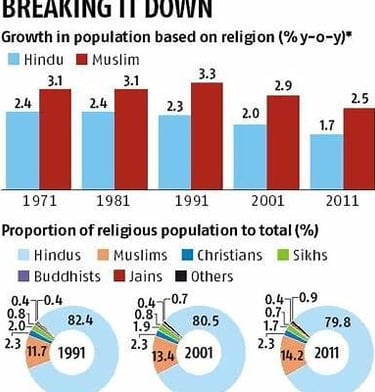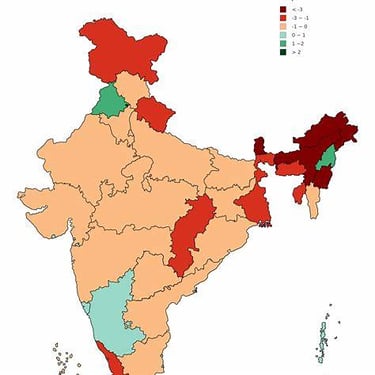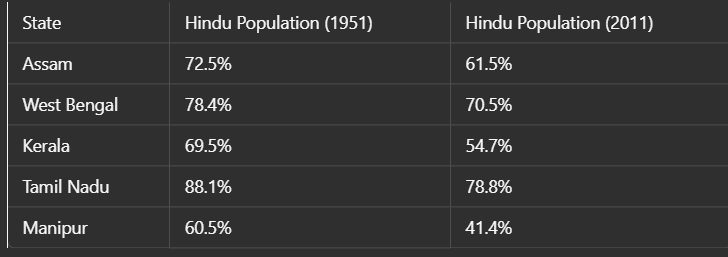
Declining Hindu Population in India: Causes, Conversions & BJP's Role
1951 Census recorded Hindus as over 84% of India's population, the 2011 Census pegged the number at 79.8%, marking a significant decline. With growing conversions, targeted campaigns, and socio-political factors, it becomes crucial to analyze the reasons behind this change
POLITICS
3/31/20255 min read


The Declining Hindu Population in India: A Threat to Cultural Heritage?
India, often called the land of Hindus, has witnessed a continuous decline in the proportion of Hindus in its total population. This shift raises concerns about demographic changes, conversions, and external influences shaping the nation's religious landscape. While the 1951 Census recorded Hindus as over 84% of India's population, the 2011 Census pegged the number at 79.8%, marking a significant decline. With growing conversions, targeted campaigns, and socio-political factors, it becomes crucial to analyze the reasons behind this change.
Hindu Population Decline: A Statistical Perspective
Over the decades, the Hindu population has seen a steady decline while the Muslim and Christian populations have grown. Here’s a year-wise breakdown based on Census data:
A 5% decline in the Hindu population over six decades might seem small, but it signifies a significant demographic shift when seen in absolute numbers.
Reasons for Hindu Population Decline
1. Lower Fertility Rate Among Hindus: Studies indicate that Hindus have a lower Total Fertility Rate (TFR) than Muslims. According to the NFHS-5 (2019-2021), Hindus have a TFR of 1.9, while Muslims have a TFR of 2.3. The lower birth rate among Hindus has contributed to the declining proportion over time.
2. Religious Conversions: The Exodus of Dalits: A significant portion of Scheduled Castes (Dalits) has been converting to Christianity and Islam, seeking social upliftment. Christian missionaries actively work among Dalits, providing education, healthcare, and economic opportunities in exchange for conversions. Islam also attracts Dalits by promising social equality and brotherhood. These conversions alter the religious composition in many regions.
3. Christian Missionaries and Mass Conversions: Christian missionaries, especially in tribal regions like Jharkhand, Odisha, Chhattisgarh, and the Northeast, have been aggressively converting Hindus. Funded by foreign NGOs, they run schools, hospitals, and relief programs, often persuading or coercing economically disadvantaged Hindus to embrace Christianity.
4. ‘Love Jihad’, The Forced Conversion Controversy: ‘Love Jihad’ refers to cases where Hindu women enter into relationships with Muslim men who later pressurize them to convert to Islam after marriage. Several state governments, including Uttar Pradesh, Madhya Pradesh, and Karnataka, have enacted laws to curb this practice. Numerous reports suggest that many Hindu women, unaware of the long-term consequences, are lured into interfaith marriages, altering demographic trends.
5. Hindu Migration from Conflict Zones: States like Jammu & Kashmir, West Bengal, and Assam have witnessed a decline in the Hindu population due to targeted violence and migration. The exodus of Kashmiri Pandits in the 1990s remains a glaring example of how demographic shifts occur due to religious persecution.
State-Wise Hindu Population Decline
Certain states have experienced an alarming drop in Hindu population percentages:
These numbers reveal how Hindu-majority states are witnessing a significant demographic transformation.
The Role of BJP in Reviving Hinduism
The Bharatiya Janata Party (BJP) has played a significant role in addressing the concerns of Hindu population decline through various initiatives. Some of their key efforts include:
1. Anti-Conversion Laws: BJP-led states like Uttar Pradesh, Madhya Pradesh, Gujarat, and Uttarakhand have introduced and strengthened anti-conversion laws to prevent forced religious conversions, particularly among Dalits and tribals.
2. Awareness Campaigns: The BJP has promoted awareness drives on Love Jihad and mass conversions, educating Hindus about religious conversion tactics and the importance of preserving Hindu traditions.
3. Resettlement of Kashmiri Pandits: The Modi government has worked towards rehabilitating Kashmiri Pandits by launching schemes like the PM Rehabilitation Package, ensuring jobs and security for the displaced Hindu community in Jammu & Kashmir.
4. Protection of Temples: The BJP has taken steps to free Hindu temples from government control in states like Karnataka and Tamil Nadu, allowing Hindu religious institutions to manage their own funds and activities.
5. Support for Hindutva Movements: The party has actively supported Hindutva organizations like VHP (Vishwa Hindu Parishad) and RSS (Rashtriya Swayamsevak Sangh), which work towards uniting Hindus and preventing conversions.
6. Revival of Hindu Culture: Through initiatives like Kashi Vishwanath Corridor, Ram Janmabhoomi Temple, and the development of Char Dham Yatra, the BJP has focused on strengthening Hindu cultural and religious identity.
7. Legal Safeguards for Hindus: The introduction of CAA (Citizenship Amendment Act) ensures that persecuted Hindus from neighboring countries like Pakistan, Bangladesh, and Afghanistan can seek refuge in India.
8. Population Control Discussions: BJP leaders have emphasized the need for a uniform civil code and a population control policy, advocating for equal fertility rates among all communities to maintain demographic balance.
Call for Action: Justice for Hindus
Stronger Anti-Conversion Laws: The Freedom of Religion Act exists in states like Madhya Pradesh, Himachal Pradesh, and Uttarakhand. However, stricter enforcement is needed to prevent forced conversions.
Educating Hindu Youth: Awareness campaigns should highlight the threats posed by Love Jihad and missionary conversions.
Legal Protections for Hindus: The government must ensure that Hindus in conflict-prone states are protected from religious persecution and forced displacement.
Promotion of Hindu Unity: Eliminating caste-based discrimination within Hinduism will discourage Dalits and tribals from converting.
Judicial Perspectives on Religious Conversions in India
Indian courts have consistently addressed the complex issue of religious conversions, balancing the constitutional right to freedom of religion with concerns about forced or fraudulent conversions.
Supreme Court's Stance on Anti-Conversion Laws: In the landmark case of Rev. Stanislaus vs. State of Madhya Pradesh (1977), the Supreme Court upheld the constitutional validity of state laws prohibiting conversions by force, fraud, or inducement. The Court clarified that while Article 25 of the Constitution guarantees the right to propagate religion, this does not include the right to convert another person.
Recent Judicial Observations: In 2022, the Supreme Court expressed concerns over forced religious conversions, labeling them as "dangerous" and a threat to national security. The Court emphasized that while voluntary conversions are permissible, coercive practices undermine the secular fabric of the nation.
High Court Interventions: In November 2022, the Madhya Pradesh High Court issued an interim order stating that adult citizens should not be prosecuted for failing to comply with certain provisions of the state's Freedom of Religion Act, 2021, particularly those requiring prior declaration before conversion. This underscores the judiciary's cautious approach towards laws that may infringe upon individual liberties.
National Crime Records Bureau (NCRB) Data on Religious Conversions
The National Crime Records Bureau (NCRB) compiles data on various crimes across India, including those related to religious conversions. However, it's important to note that the NCRB does not maintain a separate category exclusively for offenses pertaining to religious conversions. Instead, such incidents may be recorded under broader categories like "offenses against religion" or "promoting enmity between different groups."
Statistical Insights: While precise figures on crimes solely related to religious conversions are not delineated, reports indicate fluctuations in communal incidents over the years. For instance, certain periods have seen a decline in communal violence, while others have reported increases, highlighting the dynamic nature of inter-religious relations in the country.
Limitations of Data: The absence of specific data on religious conversions in NCRB reports poses challenges in assessing the exact magnitude and nature of issues arising from conversion-related activities. This underscores the need for more granular data collection to inform policy decisions effectively.
Conclusion
The decline in the Hindu population is not just a demographic issue; it is a matter of cultural survival. While India remains a diverse country, the decreasing proportion of Hindus raises questions about the future of Sanatan Dharma. The BJP's proactive measures in reviving Hinduism offer a ray of hope, but collective efforts from society are also needed. Without strong policy interventions, Hinduism could face the same fate as it did in regions like Afghanistan and Pakistan. To safeguard the Hindu way of life, Hindus must stay united, vigilant, and proactive in preserving their identity.





